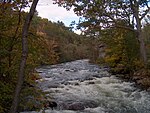Alexandria, New Hampshire
1782 establishments in New HampshirePopulated places established in 1782Towns in Grafton County, New HampshireTowns in New HampshireUse mdy dates from July 2023

Alexandria is a town in Grafton County, New Hampshire, United States. The population was 1,776 at the 2020 census, up from 1,613 at the 2010 census. Newfound Lake is in the northeast corner, with Wellington State Park on the western shore. The town is home to Welton Falls State Forest. Cardigan Mountain State Park, with Mount Cardigan, is in the west. Another attraction is Mowglis Mountain, named for Rudyard Kipling's Jungle Book hero.
Excerpt from the Wikipedia article Alexandria, New Hampshire (License: CC BY-SA 3.0, Authors, Images).Alexandria, New Hampshire
Town Pound Road,
Geographical coordinates (GPS) Address Nearby Places Show on map
Geographical coordinates (GPS)
| Latitude | Longitude |
|---|---|
| N 43.611388888889 ° | E -71.792777777778 ° |
Address
Town Pound Road 2
03222
New Hampshire, United States
Open on Google Maps









